ASUS UL80Vt and G51J: Going for the Gold
by Jarred Walton on December 15, 2009 1:30 AM EST- Posted in
- Laptops
ASUS G51J Gaming Performance
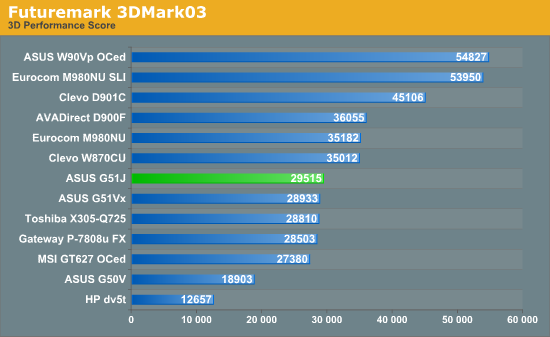
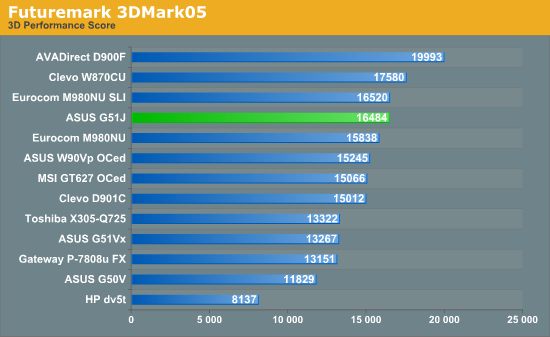
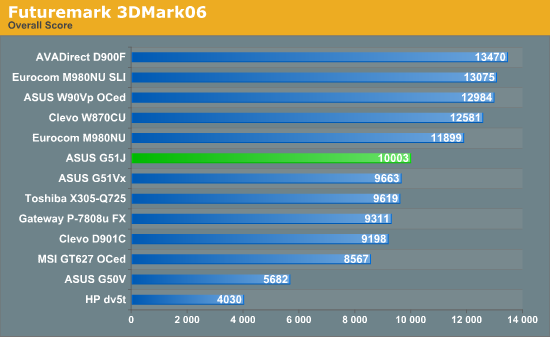
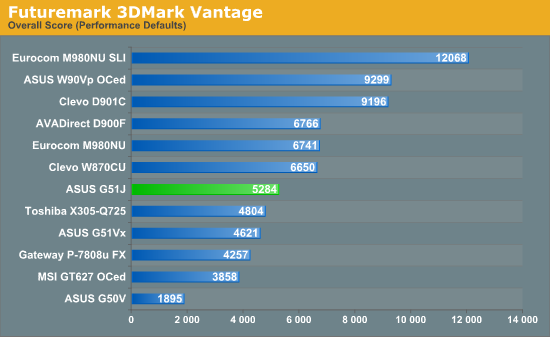
3DMark shows more of a theoretical potential for the various GPUs, before CPU performance becomes a potential bottleneck. Granted, most of these laptops have CPUs that are plenty fast, but just as no two games show identical requirements, 3DMark is at best one additional test to run rather than a replacement for gaming benchmarks.
We do have G51Vx results, which are missing in the gaming tests, and two of the 3DMark versions (03 and 06) show less than a 5% difference between the G51J and G51Vx. 3DMark05 and Vantage on the other hand show the G51J leading the G51Vx-A1 by 24% and 14%, respectively. In our limited gaming tests on the G51Vx, we didn't encounter any performance issues that were different from what we see on the G51J; at 1680x1050 or 1920x1080, the GTX 260M GPU is the major bottleneck on either system.
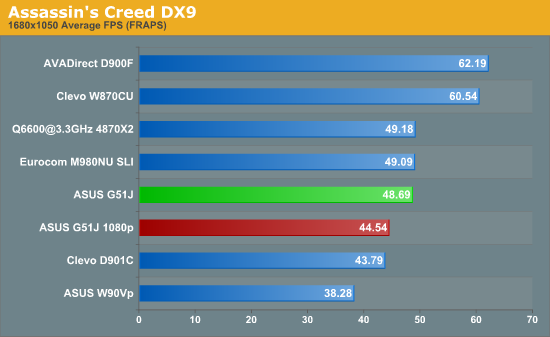

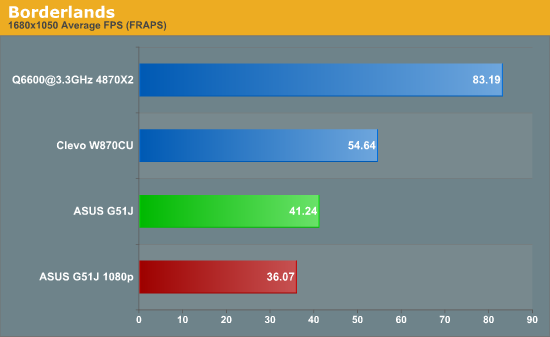
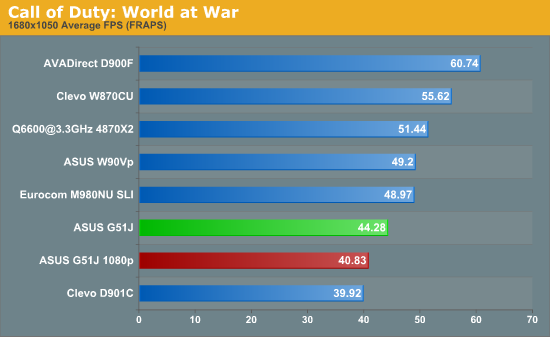
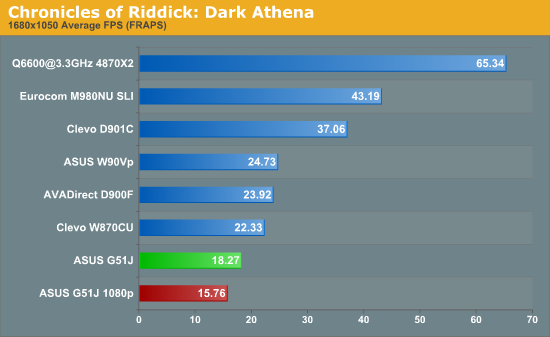
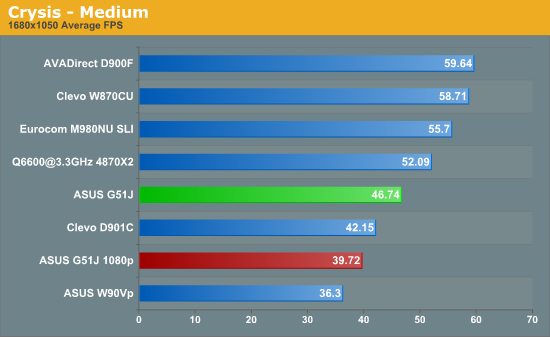



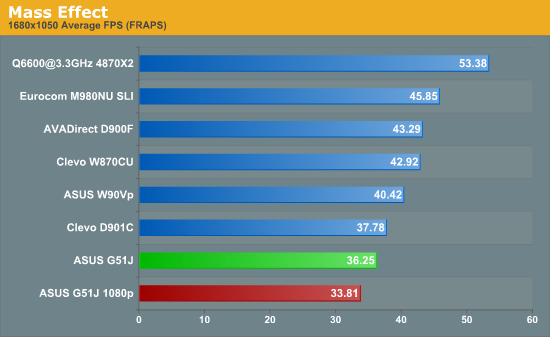
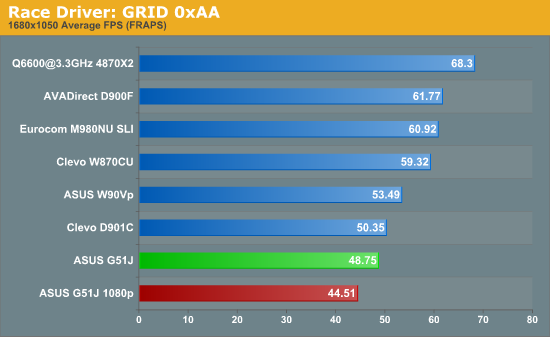
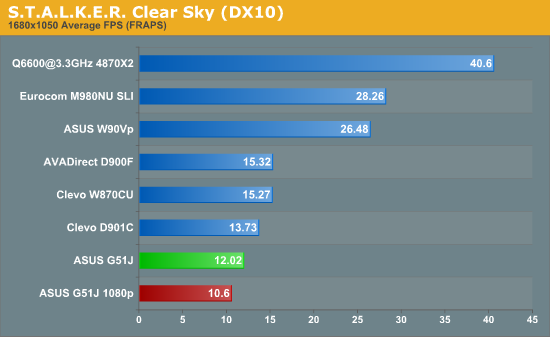
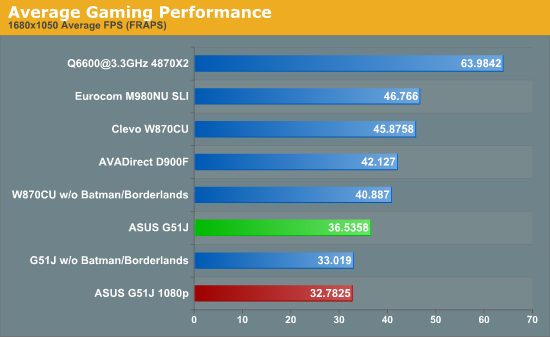
Gaming performance shows just how well the G51J does for the price. The W870CU is about 25% faster, but it's pretty much all from the GPU in these tests. That's about in line with the minimum price difference to upgrade to a notebook with GTX 280M (currently those start at around $1800). In the vast majority of games, either you can run at max detail settings without trouble or you'll need to turn down some settings on both the GTX 260M and the GTX 280M. If that's not acceptable, you could look at SLI GTX 280M solutions, but they're a big step up in price and we're still stuck with Core 2 models in that case.
Outside of antialiasing, we maxed out the settings for all of the games we test. Dark Athena, Crysis, Empire: Total War and STALKER: Clear Sky are too demanding for mobile GPUs at those settings, but Medium to High detail will work fine, even at 1080p. If you're one of those people that feel a need to max out every game setting, perhaps gaming laptops aren't the best idea. For most, the difference between High and Max is going to be relatively small in practice, and there are many titles (i.e. not Crysis) where even maximum detail will work well.










66 Comments
View All Comments
whatthehey - Tuesday, December 15, 2009 - link
Thanks for that; now go blow more smoke up Jobs' arse and leave the real discussion to people that can think.Calling this a cheapo Asus to try and make you Mac look better is pathetic. What makes it cheap, other than a plastic body? Most laptops are plastic shells, and this is still $40 less than the plastic MacBook while offering superior battery life and gaming performance. Plus I wouldn't have to put up with OS X and its quirks. Anand may love that stuff but I'd just as soon stick with Windows. No contest over glorified Apple.
KutterMax - Tuesday, December 15, 2009 - link
Congratz to ASUS for the UL80Vt which looks to be a very nice portable machine that still has some pretty reasonable gaming performance coupled with great battery life.ASUS has made some great computers. I picked up a "Lamborghini" a few years back and still really like it. However the very short battery life and heft did not make it the best travel companion.
I recently picked up a new Sony Z-series with a 2.8GHz processer, a couple extended batteries, and built-in Bluray. Granted it wasn't cheap, but the laptop is pretty slick. Sony allow put a great display on it and Blurays look outstanding. Importantly - it plays Torchlight great...
Basilisk - Tuesday, December 15, 2009 - link
"... if you're talking a difference of 10W to 14W, that's a 40% increase in power requirements - or 40% less battery life."I believe the correct statement is "29% less run-time":
RT = Wh / w ; RT reduction = 100% * (1-10w/14w) = 28.6%
By analogy, your metrics would suggest a 100% loss in run time (= zero time) if the draw was 20 watts, whereas its actually a 50% reduction.
JarredWalton - Tuesday, December 15, 2009 - link
Sorry... was being lazy when I wrote that. It would mean the lower power gets 40% more battery life, but as you point out the higher power draw is 29% less battery life.Wolfpup - Tuesday, December 15, 2009 - link
Notebookreview's forums have reported major stability issues with that specific model:http://forum.notebookreview.com/showthread.php?t=4...">http://forum.notebookreview.com/showthread.php?t=4...
That's really uncommon for Asus laptops, but seems to be the norm for this model, so...I take it the review unit didn't have those issues?
I run Folding @ Home on both my CPU and GPU when I'm not gaming or watching Blu Rays, so one way or another my hardware's always getting hit hard...need it to be 100% stable.
Also, regarding Vista or 7 losing power settings, I've never had that happen, though I always use "always on" and always do a clean install of the OS (I wasn't running much Asus software on my N80nv on Vista, and didn't install any under 7).
JarredWalton - Tuesday, December 15, 2009 - link
I didn't have any stability issues with the G51J during testing. That said, I highly caution against running Folding@Home (SMP or GPU) on a laptop. I used to do that and found that it seemed to cause serious problems after 6 months or so... that it just pushed the hardware beyond where it was intended. I sometimes wonder if all the "failing NVIDIA mobile GPUs" isn't somehow related to a lot of people running such apps, but that's probably oversimplified.In short, while I respect what the Folding teams are doing, I've determined that intentionally stressing hardware is a good way to make it fail sooner rather than later -- even if the hardware was once "100% stable". The benefit to me personally doesn't outweigh the cost... and if you're running a "folding farm" with desktops, your costs can very easily scale into the realm of $100+ per month for power, let alone hardware. :|
Wolfpup - Tuesday, December 15, 2009 - link
Thanks for the info! Glad to hear it was stable.I guess my N80 is a guiness pig for Folding then. If it does fail, that'll force me to upgrade :-D
Glock24 - Tuesday, December 15, 2009 - link
I'm currently frustrated because I want to buy a new laptop, but it seems every manufacturer only ordered 1366x768 screens, be it for 12", 14", 15.6", or even 16" or 17" laptops.I was seriously considering an Asus N81Vp, and the only screen available is.... you guessed it, 1366x768. My current laptop, an Asus F8Va has a 14.1" 1440x900 screen, so you may understand my disappointment.
I think manufacturers are trying to squeeze every penny they can putting those cheap 16:9 screens on every laptop. They do not realize we, the consumers, also use our laptops to work and not just to watch movies.
1366x768 is ok for a netbook, not for a real laptop.
strikeback03 - Tuesday, December 15, 2009 - link
Seriously. The UL50 (15.6" version) sounds like a laptop I would consider, but not with anything less than a 1680x1050 screen and a decent contrast ratio.On a side note, has anyone had trouble with Win7 blanking their screen but not actually turning it off? On both my desktop and laptop after the "turn screen off after" time has elapsed, the screen will flick off then back on, and stay on but blank. Any way to fix this?
yacoub - Tuesday, December 15, 2009 - link
Looking forward to a review of the new ASUS EeePC Seashell 1201N-PU17-BK. That's an interesting one - dual-core, ION, 12" display, etc.